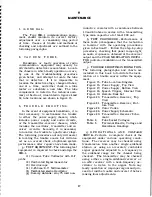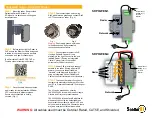
constant amplitude over the entire frequency
range.
3. T R A N S M I S S I
0
N
W
I T H
C ARRIER.
When
it
is desired to radiate the carrier
as
well as one sideband, the CARRIER switch,
8202, is turned to IN. This reinserts the
250 kc carrier signal after filter FL201 at
the input of the 2nd balanced modulator,
V206, along with the 251 kc sideband signal
passed by the filter. (See figure 5.) Both
these signals are then heterodyned up to the
final output frequency, maintaining the fre
quency difference between carrier and side
band the same as in the original signal.
Again assume an output of 15,650 kc from
the channel crystal oscillator (V208). The
radiated signal would then be composed of a
14,250 kc carrier and the lower sideband
(14,249 kc) produced by the 1 kc tone. This
composite signal can be detected by any
standard AM receiver which can be tuned
to this frequency.
4. R E C E P T I
0
N.
�·
The operation of the receiving section
is essentially the reverse of the transmitter
operation. Again assume that the intelligence
signal is a 1 kc tone and that the frequency
of the crystal oscillator V208 is 15,650 kc.
The frequency of the received single-sideband
signal would therefore be 14,249 kc (15,650 kc
minus 1400 kc minus 1 kc), the same as
for the transmitter as explained in paragraph
2, above.
b. The signal (14,249 kc) from the antenna
is fed through a contact of antenna-transfer
relay K201 and the tuned rf transformer, as
selected by CHANNEL switch S201 for the
proper channel, to the rf amplifier (V211, a
6BA6 pentode) where it is amplified and fed
to the first mixer, through the proper rf
transformer selected by t h e CHANNEL
switch. RECE I V E R GA I N control R271
controls the bias on this tube and on the
first i.f. amplifier tube, thus controlling the
gain of the receiver.
.£·
In the first mixer (V212, a 6BE6
pentagrid converter), the single -sideband
signal (14,249 kc) is mixed with the channel
crystal frequency (15,650 kc) from crystal
oscillator V208 with the CHANNEL switch
(S201) selecting the proper crystal. The
12
output of V212 thus contains the sum and
difference frequency components (29,899 kc
and 1401 kc respectively). RF interstage
transformer T203, peaked at 1400 kc, passes
the 1401 kc but rejects the 29,899 kc signal.
d.
The resultant signal (1401 kc) is fed
into-the second mixer (V21 3, another 6BE6
converter) where it is mixed with the 1150kc
output of crystal oscillator V209 to produce
sum and difference frequencies (2551 kc and
251 kc).
The resultan t signals are fed to
mechanical filter FL202, peaked
for the
upper sideband and identical to FL201 used
in the transmitter .. The difference frequency
(251 kc) is passed but the sum frequency
(2551 kc) is attenuated by the filter.
e. The single-sideband signal (251 kc) is
then amplified in two stages of conventional
i.f. amplification using two 6BA6 pentodes
(V214 and V215).
I.
f. interstage transformers
T204 and T205 are of the double-tuned,
adjustable-core type. The primary of T204
and the primary and secondary of T205 are
peaked at 250 kc. The secondary of T204 is
used as a resonant wave trap tuned to
approximately 235 kc to reduce a char
acteristic spurious response of the mechan
ical filter.
f . The output signal (251 kc) from T205
is fed to the grid of the mixer-demodulator
tube (V216A, one half of a 12AT7 twin
triode) along with 250 kc output from the
crystal oscillator
(V210).
Mixing of the
two frequencies in the plate circuit of V216A
produces sum and difference frequencies
(�0 1 kc and 1 kc respectively). The output
circuit of the mixer-demodulator bypasses
the higher frequencies to ground through a
comparatively large capacitor. Thus the sum
frequency (501 kc) is bypassed to ground
and the difference frequency remains. This
difference frequency (1 kc in this case)
represents the original intelligence signal
(test tone).
g.
The intelligence signal (1 kc) is then
fed through two stages of triode audio voltage
amplification in V216B, (the second half of
a 12AT7) and V107B, (the second half of
another 12AT7).
h. The final AF amplifier stage V108
(a
6AQ5 beam power pentode) supplies audio
output through transformer T 106 to handset
HS101 and speaker LS101 when the SPEAKER
HANDSET switch (S 10 1) is in SPEAKER
position. A telephone headset may also be
plugged into PHONES jack J104 for monitoring
•
•
•
•
•
•
•
I
•
•
•
•
•
•
•
•
•
•
•
•
•
•
•
•
•
•
•
•
•
•
•
•
•
•
•
•
•
•
•
•
•
•
•
•
•
•
•
•
•
•
•
•
I
Summary of Contents for SSB-1
Page 1: ...t z LA I E a I I Cl LA I I z z C cc t LA I cc c en U z I LA I 0 IE en CD IE z Cl C U c ...
Page 4: ... ...
Page 32: ... a c CD c a 00 CD n 0 1 CD 1 CD a ...
Page 42: ...z 0 1 3 t r l r n ...
Page 44: ...R i5 Rl23 Cl22 T R114 c Figure 17 Power Supply Bottom View 40 116 rs as6 I J I I I I ...
Page 45: ... f f c t f c f f f t f f c c c t c f c f f f Figure 18 Speech Clipper Internal View 41 ...
Page 46: ...5 5 01 FRONT SOTTOM COVER OPEN 18 1 8 Figure 19 Remote Desk Set 42 I I I I I I J ...
Page 77: ......
Page 78: ......
Page 79: ......
















































